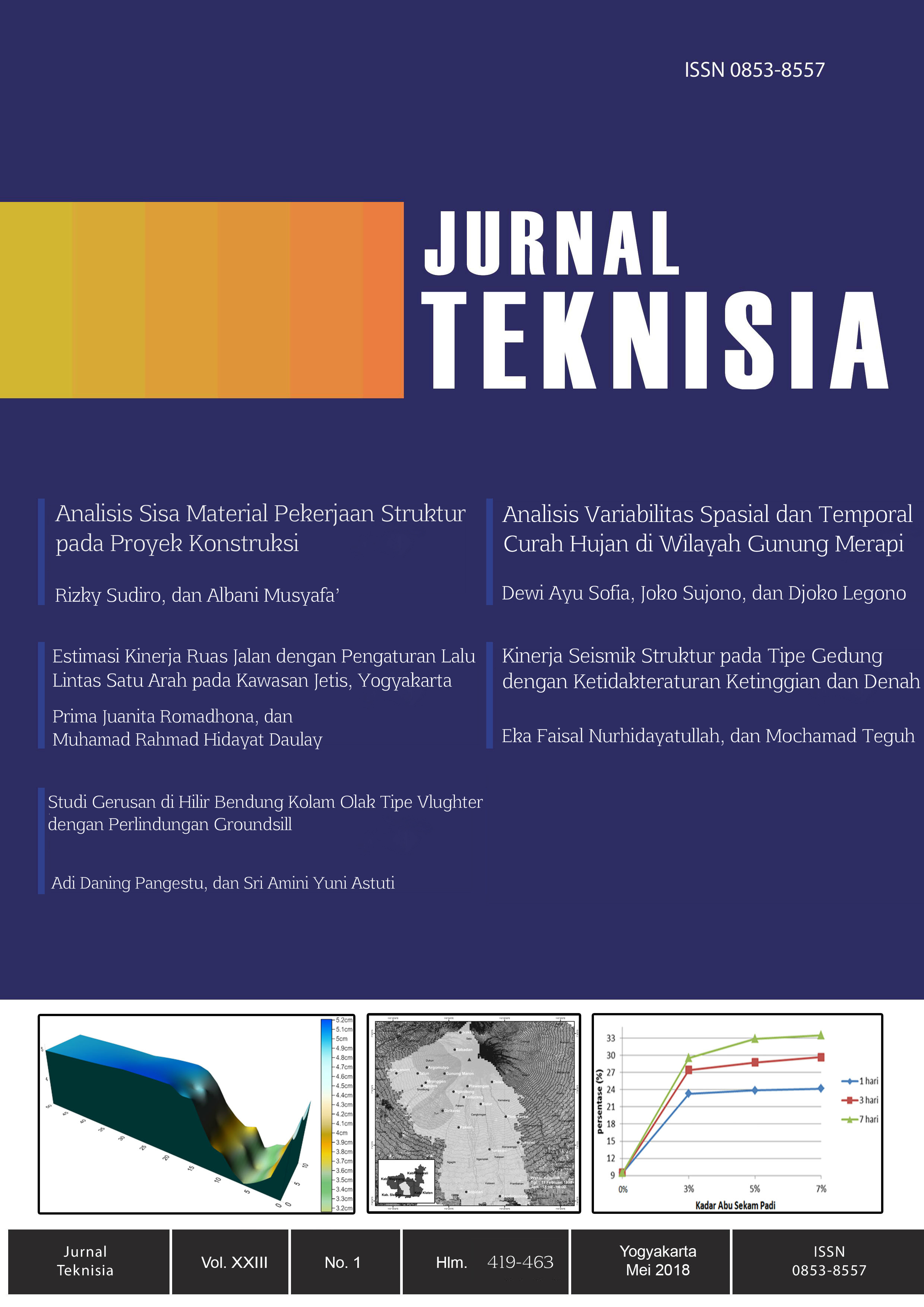Main Article Content
Abstract
Article Details
References
- Abdurrosyid, J. dkk (2009). Studi Gerusan dan Perlindungannya di Hilir Kolam Olakan Bendung Tipe USBR-I. Jurnal Teknik Sipil Universitas Muhammadiyah Surakarta. Surakarta.
- Affandi, MR. (2007). Pengaruh Kedalaman Aliran Terhadap Perilaku Gerusan Lokal di Sekitar Abutmen Jembatan. Tugas Akhir. Universitas Negeri Semarang.
- Anggrahini. (2005) Hidrolika Saluran terbuka. Srikandi. Surabaya.
- Chow, VT. (1959). Open Channels Hydraulics. Mc Graw Hill Book Company. New York.
- Fitriana, N. (2014). Analisis Gerusan di Hilir Bendung Tipe Vlughter (Uji Model Laboratorium). Tugas Akhir. Universitas Sriwijaya. Palembang.
- Mulyandari, R. (2010). Kajian
- Gerusan Lokal Pada Ambang Dasar Akibat Variasi Q (Debit), I (Kemiringan) dan T (Waktu). Tugas Akhir. Universitas Sebelas Maret. Surakarta.
- Sosrodarsono, S. (1985). Perbaikan dan Pengaturan Sungai, cetakan I. PT. Pradnya Paramitha. Jakarta.
- Sembiring, CE. (2016). Analisis Debit Air Irigasi (Suplai dan Kebutuhan) di Sekampung Sistem. Tugas Akhir. Universitas Lampung.
- Standar Perencanaan Irigasi (1986). Kriteria perencanaan Bendung Irigasi (KP 02). Galang Persada. Bandung.
- Standar Perencanaan Irigasi (1986). Kriteria perencanaan Bendung Irigasi (KP 04). Galang Persada. Bandung.
- Sucipto (2011). Pengaruh Kecepatan Aliran Terhadap Gerusan Lokal Pada Pilar Jembatan Dengan Perlindungan Groundsill. Jurnal Teknik Sipil Universitas Negeri Semarang.
- Triatmodjo, Bambang. (2012). Hidraulika I. Beta Offset. Yogyakarta.
- Triatmodjo, Bambang. (2013). Hidraulika II. Beta Offset. Yogyakarta.
References
Abdurrosyid, J. dkk (2009). Studi Gerusan dan Perlindungannya di Hilir Kolam Olakan Bendung Tipe USBR-I. Jurnal Teknik Sipil Universitas Muhammadiyah Surakarta. Surakarta.
Affandi, MR. (2007). Pengaruh Kedalaman Aliran Terhadap Perilaku Gerusan Lokal di Sekitar Abutmen Jembatan. Tugas Akhir. Universitas Negeri Semarang.
Anggrahini. (2005) Hidrolika Saluran terbuka. Srikandi. Surabaya.
Chow, VT. (1959). Open Channels Hydraulics. Mc Graw Hill Book Company. New York.
Fitriana, N. (2014). Analisis Gerusan di Hilir Bendung Tipe Vlughter (Uji Model Laboratorium). Tugas Akhir. Universitas Sriwijaya. Palembang.
Mulyandari, R. (2010). Kajian
Gerusan Lokal Pada Ambang Dasar Akibat Variasi Q (Debit), I (Kemiringan) dan T (Waktu). Tugas Akhir. Universitas Sebelas Maret. Surakarta.
Sosrodarsono, S. (1985). Perbaikan dan Pengaturan Sungai, cetakan I. PT. Pradnya Paramitha. Jakarta.
Sembiring, CE. (2016). Analisis Debit Air Irigasi (Suplai dan Kebutuhan) di Sekampung Sistem. Tugas Akhir. Universitas Lampung.
Standar Perencanaan Irigasi (1986). Kriteria perencanaan Bendung Irigasi (KP 02). Galang Persada. Bandung.
Standar Perencanaan Irigasi (1986). Kriteria perencanaan Bendung Irigasi (KP 04). Galang Persada. Bandung.
Sucipto (2011). Pengaruh Kecepatan Aliran Terhadap Gerusan Lokal Pada Pilar Jembatan Dengan Perlindungan Groundsill. Jurnal Teknik Sipil Universitas Negeri Semarang.
Triatmodjo, Bambang. (2012). Hidraulika I. Beta Offset. Yogyakarta.
Triatmodjo, Bambang. (2013). Hidraulika II. Beta Offset. Yogyakarta.
